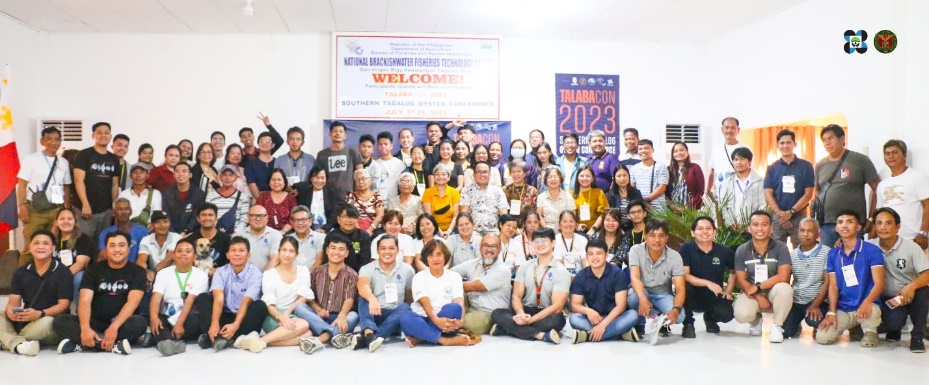Key players and experts in the oyster industry recently gathered and discussed the current state of the oyster industry in the country, as well as the contemporary methods and best practices, new technologies and developments, emerging threats, and market opportunities.
"TalabaCon: Southern Tagalog Oyster Conference” was held at the Bureau of Fisheries and Aquatic Resources of the Department of Agriculture (DA-BFAR) National Brackishwater Fisheries Technology Center (NBFTC) in Pagbilao, Quezon on July 27– 28, 2023.
The activity was organized by the University of the Philippines Diliman Marine Science Institute (UPD MSI) headed by Dr. Deo Florence L. Onda. It was conducted in collaboration with the Philippine Council for Agriculture, Aquatic and Natural Resources Research and Development of the Department of Science and Technology (DOST-PCAARRD), BFAR-NBFTC, Agriculture Sustainability Initiatives for Nature (ASIN) Inc., Commission on Higher Education (CHED) Leading the Advancement of Knowledge in Agriculture and Sciences (LAKAS)-Harmful Algal Blooms (HAB) Watch Project, and Mama Sita’s Holding Company.
TalabaCon featured presentations from Southeast Asian Fisheries Development Center (SEAFDEC), BFAR-NBFTC, UPD-MSI, BFAR-Central, ASIN, CHED, Macalelon local government unit (LGU), UP Visayas, Laguna State Polytechnic University (LSPU), BFAR-Dagupan, and IPIL Action Group. It was attended by oyster farmers, mariculture cooperative members, researchers, fisheries experts, representatives of partner government agencies, industry partners, as well as faculty and students from different academic institutions.
Lydia Morales of BFAR-NBFTC welcomed the participants with a message during the activity, while Dr. Mari-Ann Acedera, Director of Marine Resources Research Division (MRRD) of DOST-PCAARRD, presented the programs and projects that support oyster research and development.
Dr. Acedera discussed the beginning of the Site Characterization and Implementation of Innovative Sustainable Oyster Systems (SCI2SOS) program, which was funded by DOST-PCAARRD under the Collaborative Research and Development to Leverage the Economy (CRADLE) of the Science for Change Program (S4CP).
SCI2SOS program was a collaboration among UP-MSI, BFAR-NBFTC, ASIN Inc., Tambuyog Development Center, and Macalelon LGU. It aims to improve the lives of oyster farmers, improve oyster farming in Quezon, and continue the collaboration among oyster farmer’s association, ASIN, and LGU in oyster research and development (R&D).
In his keynote message, Dr. Rolando Pakingking of SEAFDEC discussed the status, challenges, and other alternative methods in oyster farming.
Other presentations and discussions included the following:
- “The seasonality of oysters in the Philippines and its implication to oyster farming” by Mr. Exequiel Gabriel Dizon of UPD MSI;
- “Threats that can cause diseases to oyster and those who love to eat oysters” by Dr. Deo Florence Onda of UPD MSI;
- “Localized disaster risk deduction and management on oyster farming” by Mr. Roy Ortega of BFAR-NBFTC;
- “Roles of the private sector, fisherfolk, national government agencies, and researchers” by Mr. Raymond Rodolfo of ASIN Inc.;
- “Challenges on establishing and expanding oyster industry particularly in Macalelon” by Macalelon Municipal Agriculturist Guillermo Tan II;
- “Threats of harmful algal blooms (HABs) to oyster farming in Tayabas Bay” by Mr. Robert Jay Ramos of UPD MSl;
- “A live demonstration on remote settings of oyster on how to process the oyster spots cultches before it is distributed to deeper areas” by Mr. Hillel Cabria of ASIN Inc.;
- “Threats to oyster farming including pollution, climate change and possible diseases of oysters, the effects of microplastics on the growth of oyster and microplastic fiber contamination of collected oyster from selected area in the Philippines” by Dr. Philip Ian Padilla and Microbial Ocenaography Laboratory (MOLab) staff;
- “Results of research in Pagbilao Bay, Quezon on the invasive black mussel on oyster and the oyster nurseries in earthern ponds” by Mr. Lowell James Santiago of LSPU and Ms. Randel Ruado of ASIN Inc.;
- Plan for Joint Molecular Facility and Laboratory funded by DOST-PCAARRD under the projects of HABs Watch and newly approved VirOys with the collaboration of UPD MSI, BFAR-NBFTC and CHED by Dr. Onda;
- “Gaps and future directions of the oyster industry in the Philippines” by Dr. Dennis Tanay of BFAR-Dagupan;
- Quality standard of oyster used on Mama Sita products by Mr. Mark Lapus of Mama Sita’s Company;
- “Ways to grow-out quality oysters and how it can be used to make other products” by Ms. Rizalyn Bautista from BFAR-Dagupan; and
- “Different advantages and disadvantages of methods of oyster farming in different parts of the Philippines” by Dr. Junemie Lebata-Ramos from SEAFDEC.
Oyster farmers from Padre Burgos, Quezon also shared their knowledge on joining the oyster conference. According to them, they had learned that everyone is equal and has roles in the oyster industry.
According to Dr. Acedera, the continuation of this initiative will sustain the oyster industry not only in Quezon but for the whole Philippines. The conference hoped to bring together the different sectors to share new knowledge, discuss issues faced, and cooperate in meeting the challenges for the collective development of the oyster industry.

Dr. Mari-Ann M. Acedera giving her welcome remarks during the TALABACon 2023. (Image Credit: MRRD-PCAARRD)

Participants, guests, and oyster farmers/growers during the TALABACon 2023. (Image Credit: MRRD-PCAARRD)

